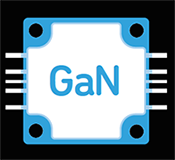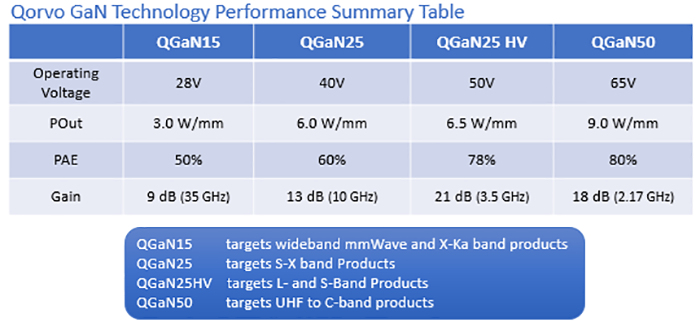65 V GaN Transforms the Radar Market: Here’s What it Means for You
March 20, 2020

65 Volt GaN is forging a new generation in radar systems that aim to advance security and monitor a number of commercial applications. 65 V GaN is also helping boost radar market growth through 2027. According to Strategy Analytics, the radar market is set to exceed $1 billion by 2022, with 65 V GaN expected to penetrate a major portion of this marketplace.
In this blog post, we examine how this technology is transforming radar systems and contributing to this growing area.
Brief Background on Radar Applications
Radar equipment is prominently used in security for the defense sector across all nations. Primarily developed for defense and military purposes, these radar systems are extensively used in commercial sectors as well – such as air traffic, marine, meteorological monitoring and aircraft anti-collision systems.
Radar systems in military applications improve security. Growing safety and security applications and increases in defense budgets will propel demand for these systems. Technological advancements such as power amplification are also leading to the development of lightweight radars and are helping to positively influence market growth. Additionally, these technology advancements aim to reduce system sizes, which opens up a variety of new opportunities for commercial and maritime radar equipment.
The RF Technology Role in Radar
Over the years, there have been several RF amplification technologies used in radar systems, such as Silicon Bipolar, Silicon LDMOS, Gallium Arsenide (GaAs) and tube base products like traveling wave tube technology. Most recently, Gallium Nitride (GaN) HEMT has been the RF and microwave power technology taking over the radar application market because of its superior technological properties.
GaN has quickly gained favor for many applications because of its high gain and high-power levels at L-band and above, and more recently in UHF. GaN HEMT transistors are most often produced on silicon carbide (SiC) substrates that offer excellent heat extraction for long-term reliability. GaN-on-SiC is ideally suited for high-power pulsed applications and its power density allows for optimal cooling. Due to this superior power density, the output capacitance per watt will be much lower. This enables harmonic tuning at the output with high efficiency, usually in the range of more than 70-80 percent in the kilowatt (kW) power levels.
Read other material on 65 V GaN
Qorvo Introduces 1.8 kW, 65 V GaN-on-SiC Transistor
Qorvo Introduces Industry’s Most Powerful GaN-on-SiC Transistor
Why High Voltage 65 V GaN?
Long-range radars are most widely used in the aerospace and defense sector. These radars are deployed to meet surveillance objectives, including weapon detection and target location. The most common military radar markets are the UHF radar, AESA radars, the aerospace identification friend or foe (IFF) and distance measuring equipment (DME). These markets require power amplification in the higher hundreds to thousands of watts. In these kW ranges, typical amplification is attained by combining multiple solid-state power transistors or using tube-based solutions.
However, Qorvo has created transistors in these high watt ranges by using higher operating voltage GaN. Qorvo’s 65 V operating voltage GaN not only attains the higher power kW amplification, but also maintains a better thermal solution for these radar applications. Additionally, it attains the IFF and DME application target parameters in a smaller form factor more reliably.
The Benefits of 65 V GaN
Radar design engineers are challenged given the high level of complexity in today’s radar systems. Today’s and next-generation systems must be smaller and operate at lower operating cost. These three key market drivers are pushing radar engineers toward solid-state solutions, like GaN.
65 V GaN-on-SiC achieves the above goals of small form factor, lower operating cost and reduction of RF front-end complexity. Using higher operation voltage at the transistor level creates flexibility for designers as it enables high kW output power using a single transistor. It also reduces the design complexity by combining fewer transistors to achieve radar system power levels. These high-voltage high-power transistors are highly efficient, measuring in the range of 70-80 percent at UHF and L-Band frequencies.
To show the true advantages of 65 V GaN-on-SiC, let’s compare LDMOS and 65 V GaN-on-SiC in a radar application. Using LDMOS requires system engineers to create complex power combining to get to the multi-kW power levels, while GaN-on-SiC transistors simplify the amount of combining using fewer devices to achieve the same power level. This saves design time while reducing system complexity and cost. Another benefit of higher voltage is lower currents. For the same amount of output power, a GaN-on-SiC system operating at 65 V will have less DC current required from the power supply, which enables smaller conductors, lowers the DC losses and decreases weight. Additionally, GaN-on-SiC has a much higher efficiency than LDMOS.
From the start, GaN-on-SiC provides a higher electric field strength than silicon-based LDMOS solutions. Its higher electron mobility enables smaller form factors for a given on-resistance and breakdown voltage than LDMOS. 65 V GaN-on-SiC features:
- Higher power density – reduces the number of transistors and overall component size
- Lower power consumption – reduces the system-level current losses and demand on power supplies
- Easier matching capability – output power can be raised while keeping useable output impedances
Today’s radars are increasingly using GaN-on-SiC RF transistor technology for several reasons, including higher power, high efficiency, increased robustness, lower power consumption, reduced size, frequency availability, higher channel temperature and its extended lifetime. These benefits combine for an overall increase in performance in radar systems. As you can see in the table below, Qorvo GaN-on-SiC technology has evolved to create many varieties suitable for a wide array of radar applications. Recently, while collaborating with radar customers, Qorvo has developed a specific 65 V GaN-on-SiC solution. This 65 V GaN technology can more effectively reach the higher power target requirements for today’s radar applications.

As shown in the table below, Qorvo has multiple GaN devices suitable for covering the UHF and L-Band radar market. With their high Power Added Efficiency (PAE), these transistors reduce system temperature, size and weight.
GaN-on-SiC 65 V Transistors
| Part Number | Frequency (MHz) | Watts | Gain (dB) | PAE (%) | Package Style |
|---|---|---|---|---|---|
| QPD1013 | DC-2700 | 150 | 21.8 | 64.8 | DFN |
| QPD1025 | 960-1215 | 1800 | 22.5 | 77.2 | 4 lead NI-1230 (Earless) |
| QPD1025L | 960-1215 | 1800 | 22.5 | 77.2 | 4 lead NI-1230 (Eared) |
| QPD1026L | 420-450 | 1300 | 25.9 | 80.8 | 4 lead NI-1230 (Eared) |
| QPD1029L | 1200-1400 | 1500 | 21.3 | 75.0 | 4 lead NI-1230 (Eared) |
The Takeaway
Radar applications continue to grow exponentially serving many military and commercial markets. Qorvo’s GaN scientists have collaborated with radar customers in these advancing areas to create products optimized for their unique applications. 65 V GaN-on-SiC is one of the solutions developed in an effort to match the best technology with evolving application needs. Qorvo’s 65 V GaN solutions allow radar system engineers to design more competitive, lower cost radars with lower operating expenses over their lifetime. Not only has Qorvo 65 V GaN met the needs of our radar customers, it has also shown how customer collaboration can help catapult existing technology into new market areas to help RF design engineers create next-generation best-in-class radar solutions.
Have another topic that you would like Qorvo experts to cover? Email your suggestions to the Qorvo Blog team and it could be featured in an upcoming post. Please include your contact information in the body of the email.